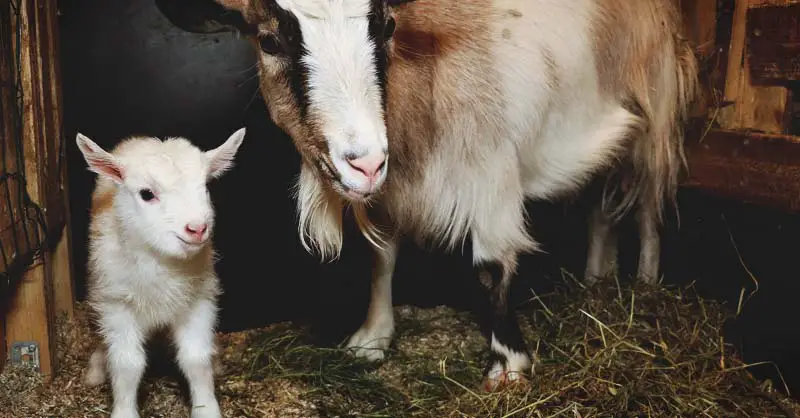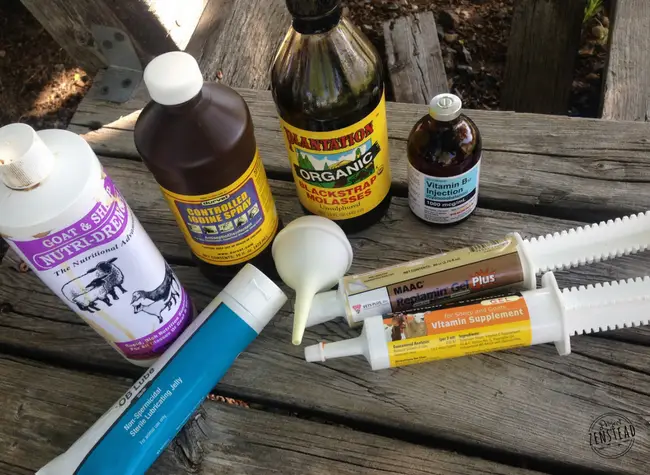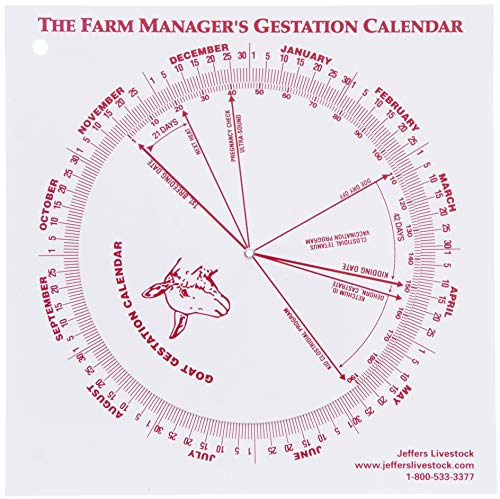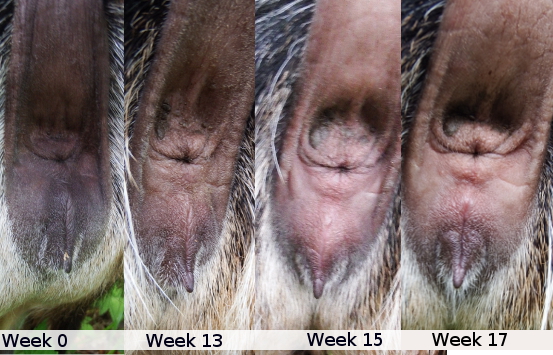
So, your does got bred by an amazing buck and you are almost to the 5-month mark since that time. You and your does are getting anxious for kids to start making their grand entrances into this world.
But you have questions:
- What do my does need?
- How do I know when she is kidding?
- When do I need to call the vet?
And many more questions!
This guide will help you recognize the signs of kidding, walk you through your first-time goat kidding, how to take care of mom and baby postnatally, and give an overview of supplies you will need.
Table of contents
- Goat Kidding Supplies – Your Complete Goat Kidding Supply List
- Goat Kidding Pens
- Goat Kidding Barn
- Goat Kidding Record Book
- Goat Kidding Signs
- Goat Kidding Calendar
- Goat Kidding Calculator
- Goat Discharge and Vulva Changes Before Kidding
- Goat Kidding – When Your Goat is in Labor
- Goat Kidding Positions
- Goat Kidding Problems
- How to Tell if Your Goat is Done Kidding
- Goat Care After Kidding
- Goat Diarrhea After Kidding
- How Soon After Kidding can a Goat be Bred
- When to Start Milking a Goat After Kidding
- Goat not Producing Milk After Kidding
- Conclusion
Goat Kidding Supplies – Your Complete Goat Kidding Supply List

First up are supplies. To be a good goat farmer you need to follow the scout motto and be prepared when it comes to kidding.
Here is a list of things you will want to have on hand before newborn kids start making their grand entrance:
- Your vet’s phone numbers (normal hours number and after-hours number)
- Towels
- Latex Gloves
- OB Lube
- Dental Floss (unflavored)
- Iodine
- Rubbing Alcohol
- Surgical Scissors
- Colostrum Replacer
- Milk Replacer
- Kid Bottle
- Heat Lamp
- Wood Shavings or Straw
Having all of these items ready before kidding takes place can save you a lot of heartache and impromptu fixes when kidding occurs.
Goat Kidding Pens

One of the most important things you will need prepared for your does are kidding pens.
Kidding pens give your does a safe environment to kid in as well as giving you control over the kidding environment. The Manitoba Goat Association writes:

“Kidding pens can be designed for individual does or one big pen for several does. A pen of size 5 x 5 ft is sufficient for an individual doe. First time mothers or does with multiple kids may benefit from an individual pen.
Always avoid overstocking of kidding does. Clean the pens at least 3-4 weeks before bringing the does in and spread clean straw for bedding. Replace the bedding before putting a new doe into the same pen for kidding. Provide enough shelter to the does and to the kids from harsh weather.”
There are many ways to build a kidding pen, or you can buy one if you feel so inclined. Hilltop Acres Homestead has a great video tutorial on how to make a Goat Kidding Pen using cattle panels. This option will save you money over buying a premade pen.
If you do choose to buy a pen you can with something like the Lucky Dog 5×5 Kennel for $210 off of Amazon.
Goat Kidding Barn

Building or buying a goat kidding barn is something that you will want to have done before your goats start kidding. This will provide your does and kids with the shelter and protection they need from the elements.
The size of your barn will depend on how many does you plan on kidding at one time. Construct 101 has a great Goat Barn Plan that you can use as a template if you choose to build your own.
Or if you would rather buy a barn, you can buy something like the 12×16 Best Barn from Lowes for $3,000.
Goat Kidding Record Book

To know when each doe is due, you will need to keep a record of each of your does. This record book will need to contain which buck they were bred to, the buck’s progeny, their breeding history, the doe’s kidding history, the dates that they were bred and anything else that needs to be remembered about that specific goat.
You can buy a good Goat Record Keeping Book off of Amazon for $10.
Goat Kidding Signs
Humans have signs when they go into labor, and generally they will let their healthcare provider know when they are experiencing those signs.
Goats experience signs before they go into labor too, but they can’t tell you – their healthcare provider – that they are experiencing those signs. So, you will need to be on the lookout for the signs that your goat is getting ready to kid.
Here are some of the common signs that a goat is going into labor:
- Udder Swelling
- Softening of ligaments
- Swollen vulva
- Protruding back & pelvic bones
- Reluctance to Eat
- Staying away from the herd
- Restlessness
- Discomfort
- Water bag appearance (filled with clear fluid)
You can also watch the Top 10 Signs that Your Goat is Close to Kidding by Symon Says Farms. This video will help you see what the some of the signs look like as well as well as give you some tips on how to help your goat.
Goat Kidding Calendar

You will want to have some sort of reference for your doe’s due dates. A goat kidding calendar can help you see when your does’ due dates will be according to the dates that you breed them.
A nice goat kidding calendar tool that you may find very helpful is a Goat Gestation Wheel, you can buy one on Amazon for $14. This tool will also give you other dates that you will need to know if your doe does not take as well as important things to do for her and her kid(s) after birth.
Goat Kidding Calculator
To get a good timeframe of when your doe will kid you can either count the 150 days from the time your doe was exposed to the buck or you can use a kidding calculator to go off of.
The American Goat Society has a great Goat Kidding Calculator. All you have to do is enter the date that your doe was exposed to the buck and it gives you her approximate due date.
Goat Discharge and Vulva Changes Before Kidding

Before your goat kids she will have discharge and vulva changes. Some goats may have a bit of discharge for a few weeks before they kid while others start having discharge within a few hours. The discharge you will see should look like a long string of mucus. If it is another color you will want to call your vet to ask him about it. Her vulva will also be another indicator that kidding is close as it loosens and relaxes.
Goat Kidding – When Your Goat is in Labor
You will know that your goat is in labor when her water bag breaks and she starts straining.
A very helpful video is Goat Kidding by Square One Farms. Watching this will help you recognise what a typical goat labor looks like as well as some other good advice.
Goat Kidding Positions

Typically goats are born with their front or back legs first. There are other positions, and some of them can cause huge problems for your goat.
The American Boer Goat Association has a very helpful Goat Kidding Positions infographic that you can use to learn the positions, both good and bad, that goat kids are born and how to assist if you need to.
Goat Kidding Problems
Usually goat kidding goes off without a hitch. However, there are times when veterinary intervention is necessary. Sometimes kids may be to big to go through the birth canal, they are in the wrong position, or a number of other possible problems.
Some of the signs that your goat is having problems kidding is if she:
- Has been straining hard for more than 30 minutes
- Has an unordinary amount of blood being discharged
- Seems too fatigued to continue
Any time you feel there is a problem in your goat’s labor you should call your vet as soon as you can since every minute counts.
How to Tell if Your Goat is Done Kidding
Once your doe stops straining and she relaxes you can know that she done kidding. You can also feel around belly and examine the birth canal to see if there are any other kids that are waiting to be delivered. After you have examined her and she appears done it is time to take care of the postnatal work.
Goat Care After Kidding
Your doe and kids will require care after the birth. Some of the things you will need to do are:
- Make sure your kids are breathing well
- The kids are dry
- Put antiseptic on the kids’ umbilical cords
- Make sure the doe is producing milk
- Make sure the kids are getting the milk they need
Brandon Dumas has a good Goat Care After Birth video that will show you postnatal care your doe and kids will need.
Goat Diarrhea After Kidding
Diarrhea is a sign of sickness many times in animals and needs to be addressed. After birth both doe and her kids should be watched and if they start having diarrhea they need to be looked at. Sometimes it can be something simple, but other times it can be dangerous.
Regan Hennessy wrote a helpful guide on How to Stop Baby Goat Diarrhea that may come in hand if you have a kid with diarrhea one day.
How Soon After Kidding can a Goat be Bred
Once your goat has kids and they are growing, you may start thinking about your next goat breeding. Depending on what kind of goats you have, as well as the weather in your area may determine the amount of time after kidding that your doe can be bred. As a rule of thumb though, goats can get pregnant 4 to 6 weeks after kidding.
When to Start Milking a Goat After Kidding
You will let the kids have full access to the doe’s milk for two weeks after they are born. Once they hit two weeks old you will separate them from the doe at night and milk her in the morning, returning her to her kids afterward. This will make it so both you and her kids get the milk she produces.
Goat not Producing Milk After Kidding
Most goats produce milk after kidding without any issues. If you end up with a doe that is not producing milk you will need to bottle-feed her kids. Since there are multiple reasons why your goat would stay dry, you will want to call your vet to find out the reason she is not producing milk and go from there. You may need to purchase goat colostrum or goat milk on Amazon or from another source, or get milk from another nanny. Check with your vet to find out the best course of action.
Conclusion
Goat kidding is an exciting time at your farm. It is a time that new life comes into the world and you get to pamper your does. Take the time to prepare yourself and don’t be embarrassed to call your vet for help!
References:




